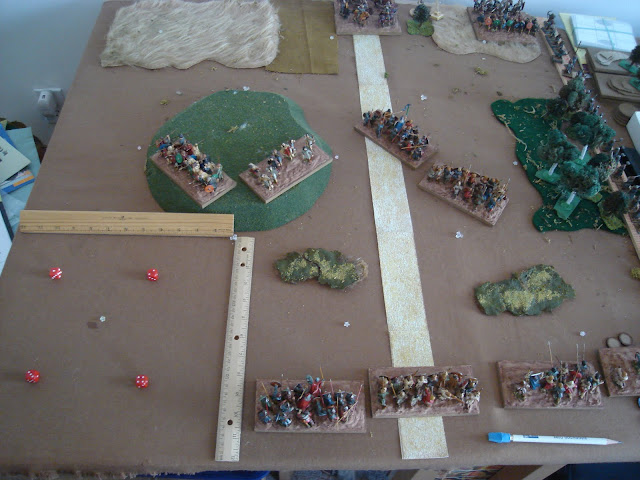
https://theoffgridcabin.com/start-here/
After lots of thinking, visits to various blogs [click], time with Bob Cordery's Portable Wargame [click], and re-visiting board games [click, click], I've decided it's time to take a set of my "6D6" rules and put it "ON the grid" - shave and a haircut required despite it being a Dark Ages game with "Spear to the Strife".
As we've been working on "higher level command" wargames [gamer is division or corps commander], it is more apparent that the limitations inherent in the hobby - terrain miniature, time, space, budget - make it easier to put some games on a grid rather than move freely on a table. I'd say if a Unit in a game is a brigade or higher, then it should be on a grid. This prevents the players from micromanaging their sub-units and getting bogged down with the oft-times complicated mechanics of table-top miniatures, bases, and terrain, and their interactions.
I think the freedom of movement with miniatures is more suited to skirmish, small unit, and battalion / regiment level gaming where it "feels" more realistic. Of course, in real life, your division, corps or army level staff don't get into the nitty-gritty of maneuvering Soldiers - that's the job of someone else.
To summarize, here's where my head is with grids:
More [yes, MORE] realistic!
- conceptually, the way real military leaders think
EASIER: eliminates fiddling with 1/16" and mm in/out
- slims and simplifies rules by eliminating lengthy explanations about mechanics
- eliminates pre-measuring question
- eliminates measurement arguments
More fun!
- total reciprocity of distances eliminates many "gotcha gaming" techniques
- encourages players to play their role and period, not the rules
Downsides
- tabletop gamer prejudice [STRONG prejudice]
- "feels" less real to certain mindsets [see above]
- eliminates friction elements of Unit / terrain / miniatures interaction that is sorta realistic [as long as you can't pre-measure] even if it is cluttered.
- do lose some small tactical possibilities with wiggling Units around, depending on if the mechanics of your ruleset take advantage of such things
GRIDS=SUPER EASY! The 12" squares that make up most game tables are divided by markers [beads below] with the 12" intersections being larger than the 6" intersection. below, the red dice mark the four 6" squares that make up the subdivision of the 12" grid. I could use 5 small beads, but it's not really necessary. Some people use a soft surface for terrain, like interlocking foam mats from the gym or childcare play areas [CLICK]; in that case you can use small push pins to easily demarcate large and small grids.

And this is how it looks on my table. A couple times I lost track of the spaces, but standing up and getting the overall picture cleared it right up thanks to the OHW terrain already being in 12" grids, anyway, and most terrain pieces are in 6" increments.

Mods for 6" grids
- 6" Move = 1 Grid,
- 9" Move = 1 Grid, plus 50% chance at a bonus Grid per move
- 12" Move = 2 Grids
All get one free 90 turn per move point, and one diagonal a turn.
- 3" road bonus, 50% chance at a bonus Grid per move [doesn't stack with 9" move]
- Range Brigans = 1, Archers = 2, one diagonal for Range.
- can't pass grid side or diagonal point with impassible / blocks LoS terrain on both sides.
- LoS center to center [over half to over half].
Questions
- Must use Move to melee contact?
Grids are pretty large, so table can get confined if a space adjacent to enemy Unit is automatically in melee. For now, I said "yes" you have to spend a Grid move to end in Melee contact, even when you start in adjacent Grids. I lined the Units up at the Grid edges.
- Zones of Control into adjacent Grids? Not interested in ZoC rules at the moment. I don't see all Units as moving in the order moved, or simultaneously, and centering the Units on their grid square has them apart enough that it looks OK to move around each other. Also, I don't like it when Units are in melee and not touching - looks weird to me.
- Diagonals. I like having 8 directions not just 4. It doesn't add much complexity to allow diagonal movement / shooting measurements, so I'm using them. Basic rule is you get to use one diagonal per move / shoot measurement.
That was all I felt I needed to get started. Let's see how it goes!

Having played a few games of To The Strongest! and For King and Parliament, I can say that I'm starting to get a real appreciation for grid based rules. It takes a lot of the fiddlyness and "gotcha" moments that I've seen in some games (looking at you, ADLG), but still allows for all the grand maneuvering we wargamers like to see.
ReplyDeleteTTS and FK&P also answer the questions you posed. You have to pass an order to charge an enemy in an adjacent square, units projects a ZoC into the grid square in front of the unit, and units can move diagonally if the adjacent grid aren't blocked by non-interpenetrable units.
Thanks for comment, Brian.
ReplyDeleteI have only read about "To the Strongest!" and somehow missed the grid aspect. I remember it is diceless and uses a card deck instead.
Yes, I think there is a fiddlyness and "Gotcha Gaming" aspect to miniatures that game designers need to take into account. Merely giving it a hand wave and saying "play with gentlemen" doesn't cut it. The culture of competitiveness is strong, largely due to the tournement circuit and the key rules for them have been Barker's, Games Workshop's, and Battlefront's. I don't think it is realistic, healthy, or even fun, for that matter.